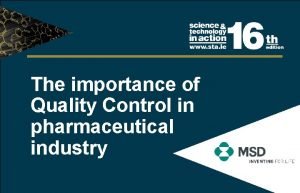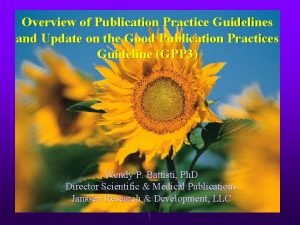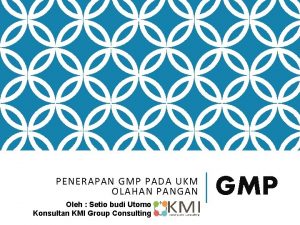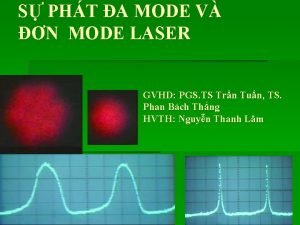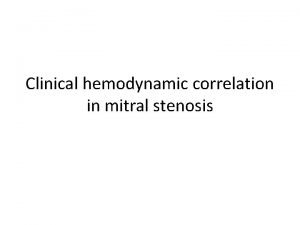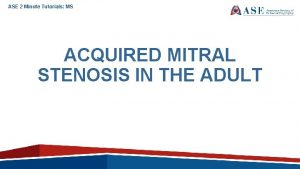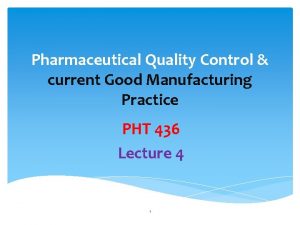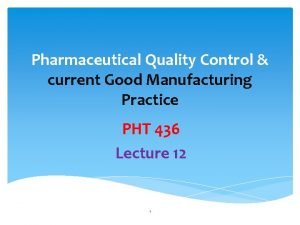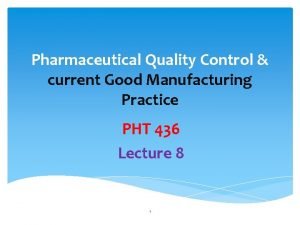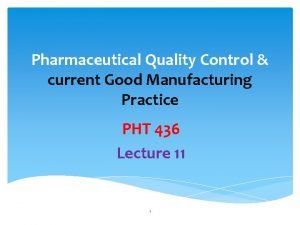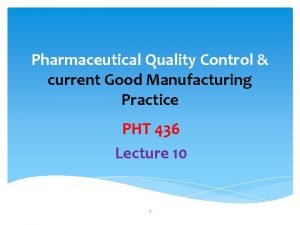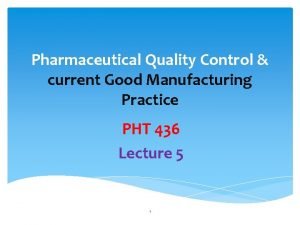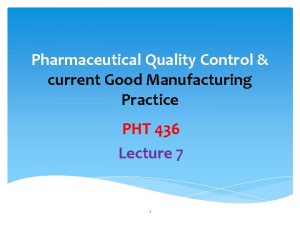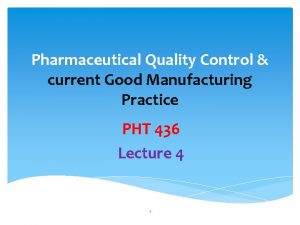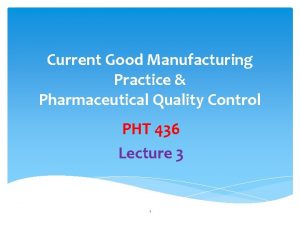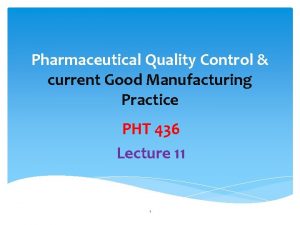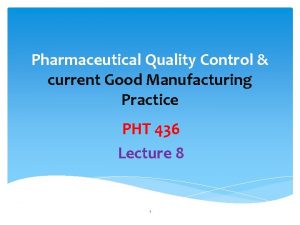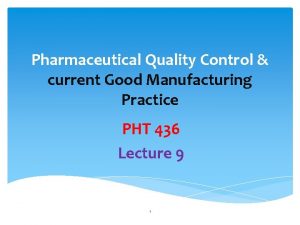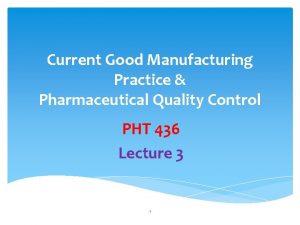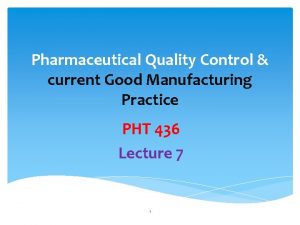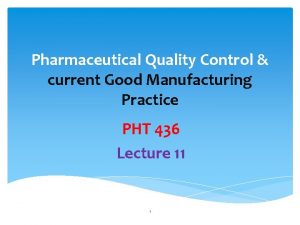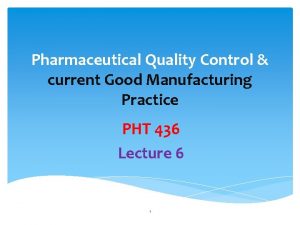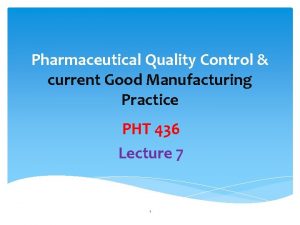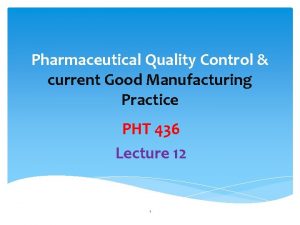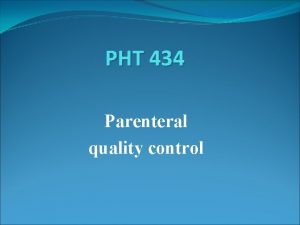Pharmaceutical Quality Control current Good Manufacturing Practice PHT





















- Slides: 21

Pharmaceutical Quality Control & current Good Manufacturing Practice PHT 436 Lecture 9 1

Current Good Manufacturing Practices Regulations Subpart E. Control of components and drug product containers and closures 211. 80 - General requirements. 211. 82 - Receipt and storage of untested components, drug product containers, and closures. 211. 84 - Testing and approval or rejection of components, drug product containers, and closures. 211. 86 - Use of approved components, drug product containers, and closures. 211. 87 - Retesting of approved components, drug product containers, and closures. 211. 89 - Rejected components, drug product containers, and closures. 211. 94 - Drug product containers and closures. 2

Sec. 211. 86 Use of approved components, drug product containers, and closures. Components, drug product containers, and closures approved for use shall be rotated so that the oldest approved stock is used first. Deviation from this requirement is permitted if such deviation is temporary and appropriate. 3

• Using oldest stock first helps: – to reduce the possibility of contamination, – and to assure that material conforms to appropriate requirements. • An exemption from strict use of oldest stock first is provided when: – it may be desirable to package using a single lot of components, containers or closures. – for evaluation of a new supplier, or new equipment or processes with respect to preferred lot of materials, – or the temporary physical inaccessibility of the oldest stock. • Materials management systems include a need to reevaluate material after a predetermined time and prior to use. This will further minimize the chance that materials in an unsuitable condition will be used. 4

Sec. 211. 87 Retesting of approved components, drug product containers, and closures. Components, drug product containers, and closures shall be retested or re-examined, as appropriate, for identity, strength, quality and purity and approved or rejected by the quality control unit as necessary, e. g. , after storage for long periods or after exposure to air, heat or other conditions that might adversely affect the component, drug product container and closure. 5

• This reevaluation will not usually require full testing but only examination of those parameters known to be subject to change. • For infrequently used materials, reevaluation may be delayed until the material is required. • Degradation is not always linear, and in some instances a limited accelerated stability study may prove advisable. 6

• For sensitive materials must be stored under the appropriate conditions where these are specified. • Where not specified it may still be advisable to identify and use positions in the warehouse that are least susceptible to the adverse climate changes. • During storage, degradation may occur, moisture may be absorbed or materials may simply become covered in dust. 7

• Re-evaluation time-scales are usually developed from historical data. Except for particularly sensitive materials, it is usual to settle or one time period often one year. • The product release label or the system should clearly indicate when materials are to be reevaluated. 8

Sec. 211. 89 Rejected components, drug product containers, and closures. Rejected components, drug product containers and closures shall be indentified and controlled under a quarantine system designed to prevent their use in manufacturing or processing operations for which they are unsuitable. 9

• Although a segregated reject area is not required if an adequate control system exists, many companies do segregate reject materials. This is an added precaution against inadvertent use. • FDA investigators frequently use a visit to the reject area as a potential source of deficiencies. – If rejections occur it is possible to assume that the vendor process is not adequately under control, and an evaluation of the cause should have been performed and documented. 10

Sec. 211. 94 Drug product containers and closures. a) Drug product containers and closures shall not be reactive, additive, or absorptive so as to alter the safety, identity, strength, quality, or purity of the drug beyond the official or established requirements. b) Container closure systems shall provide adequate protection against foreseeable external factors in storage and use that can cause deterioration or contamination of the drug product. 11

c) Drug product containers and closures shall be clean and, where indicated by the nature of the drug, sterilized and processed to remove pyrogenic properties to assure that they are suitable for their intended use. d) Standards or specifications, methods of testing, and where indicated, methods of cleaning, sterilizing and processing to remove pyrogenic properties shall be written and followed for drug product containers and closures. 12

USP provides information on specifications and test methodology for a range of container materials. These include: 1. Light transmission for glass and plastics. 2. Chemical resistance for glass. 3. Arsenic extraction from Type 1 glass. 4. Biological tests on plastics used for parenterals. 5. Physicochemical tests on plastics used for parenterals. 6. Biological tests on plastics used for ophthalmic products. 7. Chemical tests on polyethylene containers for dry oral dosage forms. 13

Current Good Manufacturing Practices Regulations Subpart G-Packaging and Labeling Control 14

Sec. 211. 122 Materials examination and usage criteria. (a) There shall be written procedures describing in sufficient detail the receipt, identification, storage, handling, sampling, examination, and/or testing of labeling and packaging materials; such written procedures shall be followed. Ø Labeling and packaging materials shall be representatively sampled, and examined or tested upon receipt and before use in packaging or labeling of a drug product. (b) Any labeling or packaging materials meeting appropriate written specifications may be approved and released for use. Any labeling or packaging materials that do not meet such specifications shall be rejected to prevent their use in operations for which they are unsuitable. 15

Specification for container and closures 1. A description of the components. 2. A statements of chemical composition and method of manufacturing when critical. 3. Size and dimension requirements. 4. Colour requirements. 5. Reference to specific manufacturing process necessary to make the article acceptable to pharmaceutical production. 6. Packaging and labelling requirements for shipment to pharmaceutical plants. 16

(c) Records shall be maintained for each shipment received of each different labeling and packaging material indicating receipt, examination or testing, and whether accepted or rejected. (d) Labels and other labeling materials for each different drug product, strength, dosage form, or quantity of contents shall be stored separately with suitable identification. o Access to the storage area shall be limited to authorized personnel. (e) Obsolete and outdated labels, labeling, and other packaging materials shall be destroyed. 17

(f) Use of gang-printed labeling for different drug products, or different strengths or net contents of the same drug product, is prohibited. Ø unless the labeling from gang-printed sheets is adequately differentiated by size, shape, or color. 18

(g) If cut labeling is used for immediate container labels, individual unit cartons, or multiunit cartons containing immediate containers that are not packaged in individual unit cartons, Ø packaging and labeling operations shall include one of the following special control procedures: (1) Dedication of labeling and packaging lines to each different strength of each different drug product; (2) Use of appropriate electronic or electromechanical equipment to conduct a 100 -percent examination for correct labeling during or after completion of finishing operations; (3) Use of visual inspection to conduct a 100 -percent examination for correct labeling during or after completion of finishing operations for hand-applied labeling. Such examination shall be performed by one person and independently verified by a second person. (4) Use of any automated technique, including differentiation by labeling size and shape, that physically prevents incorrect labeling from being processed by labeling and packaging equipment. 19

(h) Printing devices on, or associated with, manufacturing lines used to imprint labeling upon the drug product unit label or case shall be monitored to assure that all imprinting conforms to the print specified in the batch production record. 20

The midterm exam will be from lecture 1 to lecture 6. Tuesday 14/5/1437 10: 00 – 10: 50 am 21
 Good manufacturing practices in pharmaceutical industry
Good manufacturing practices in pharmaceutical industry Importance of quality in pharmaceutical industry
Importance of quality in pharmaceutical industry Good publication practice for pharmaceutical companies
Good publication practice for pharmaceutical companies Elemen cppob adalah
Elemen cppob adalah Pedoman cara produksi pangan olahan yang baik
Pedoman cara produksi pangan olahan yang baik Properties of ointment
Properties of ointment Advantages of solid dosage form
Advantages of solid dosage form Logo pht
Logo pht S'pht
S'pht Ef slope in echo
Ef slope in echo Pressure half time formula
Pressure half time formula Giá pht
Giá pht Giá pht
Giá pht Quality control and quality assurance
Quality control and quality assurance Quality management pmp
Quality management pmp Quality metrics pmp
Quality metrics pmp Basic quality concepts
Basic quality concepts Manufacturing cost vs non manufacturing cost
Manufacturing cost vs non manufacturing cost Job order vs process costing
Job order vs process costing Manufacturing cost vs non manufacturing cost
Manufacturing cost vs non manufacturing cost Manufacturing cost vs non manufacturing cost
Manufacturing cost vs non manufacturing cost Additively
Additively

